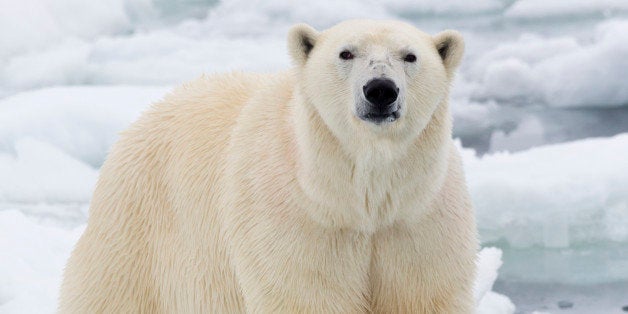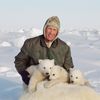
Every summer, I keep a close eye on the rate and extent of the sea ice retreat in the Arctic. I know that sea ice can only decline as we continue to pump increasing quantities of greenhouse gases into the atmosphere. But I keep my fingers crossed that natural variation in weather and climate patterns will moderate this human-caused trend, giving polar bears more time as they wait for us to reduce our emissions.
This July, the average sea ice extent dipped to the fourth lowest level recorded for the month. Thankfully, for the bears it was not a record retreat. But it was still 1.85 million square kilometers lower than the July average -- an area nearly three times the size of Texas! And this summer's sea ice losses continue the long-term declining trend.
For polar bears, it's all about sea ice. Arctic ice is essential to their survival: they rely on it to hunt, breed, and sometimes to den. When forced ashore by melting ice, polar bears are sustained by their fat reserves until the ice forms again in fall. But longer ice-free seasons are stretching the limits of those reserves.
When I began my polar bear studies in Alaska in the early 1980s, I could stand on the northern shore in summer and see polar bears hunting for seals on the nearby ice. Today, I see only open water because the pack ice has retreated hundreds of miles from the coast -- far from the productive, near-shore hunting grounds that polar bears prefer.
But climate change is not just about polar bears. This year, fires in the boreal forests of Canada, just south of the polar bear's arctic domain, have blazed across an area six times larger than the average of the past 25 years. The extent of recent boreal fires is unprecedented when compared with the paleo-fire records of the past 10,000 years.
Indeed, global warming threatens all the world's ecosystems, from the boreal forest to coral reefs and the African savannah. And some of our most iconic and beloved animals are likely to be the first to suffer the impacts.
On the savannahs of southern Africa, far from any sea ice, a warmer and drier climate complicates the many challenges already facing endangered cheetahs. Scientists have helped the cheetah's prospects by managing grazing, controlling invasive shrubs, and preventing livestock depredation -- but these gains will be for naught if we allow the climate to continue to warm.
Recognizing that the world's largest four-legged predator and the world's fastest both face extinction at the hand of human-caused climate change, Polar Bears International has joined forces with the Cheetah Conservation Fund. Working together to bring attention to the threats both species face in a warming world will, we hope, expand the dialogue on climate change and motivate meaningful action.
Because climate change threatens all life on earth, protecting polar bears and cheetahs may seem to be only one part of the equation. But it is in fact a critical part. I'm often asked: do we still have time to save polar bears? My own research and that of many others provides an emphatic yes. And, if we act in time to save polar bears, we also will save cheetahs, their African savannah habitat, and the rest of life on earth as we know it.
So, what meaningful actions can we take? Every individual must be committed to living sustainably and must think carefully about our society's energy sources. Most important, all of us must speak up in favor of sustainable policies and make informed choices at the ballot box. We must object to and reject business and policy leaders who continue to delay and distract us from wise emissions policies.
Scientists have known for over 100 years that the world can only warm if we increase the atmospheric concentrations of greenhouse gases. Therefore, when business or policy leaders stand up and tell us that climate warming is uncertain, we know they are misleading us. Whether they are intentionally lying or simply too handicapped by their beliefs to recognize the truth, they must be rejected.
Now, more than ever, we must all show our support for a low-carbon and sustainable future. We must speak up for polar bears, for cheetahs, for countless other species -- and for our children and grandchildren.
As the wise Jedi Master told Luke Skywalker, "Try not. Do or do not. There is no try." When it comes to the multiple challenges of climate change there truly is no more try. We must simply do -- and I am optimistic that we will.
This post is part of a month-long series produced by The Huffington Post in conjunction with a variety of events being held in September recognizing the threats posed by climate change. Those events include the UN's Climate Summit 2014 (to be held Sept. 23, 2014, at UN headquarters in New York) and Climate Week NYC (Sept. 22-28, 2014, throughout New York City). To see all the posts in the series, read here.
